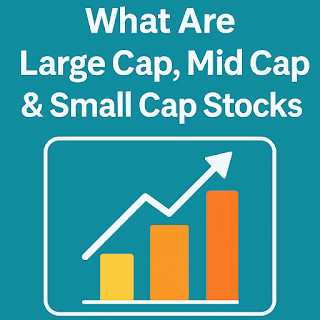What Are Large Cap, Mid Cap & Small Cap Stocks?
In the stock market, companies are categorized based on their market capitalization (market cap), which is calculated as:
Market Cap = Share Price × Total Number of Shares Outstanding
1. Large Cap Stocks
- Definition: Market cap of ₹50,000 crore or more
- Features: Stable, low-risk, consistent performers
- Examples: Reliance Industries, TCS, HDFC Bank
✅ Best for conservative or long-term investors
2. Mid Cap Stocks
- Definition: Market cap between ₹10,000 crore and ₹50,000 crore
- Features: Balanced risk-return, growing companies
- Examples: Voltas, AU Small Finance Bank, Aditya Birla Fashion
🚀 Best for moderate-risk investors seeking growth
3. Small Cap Stocks
- Definition: Market cap below ₹10,000 crore
- Features: High growth potential, higher volatility and risk
- Examples: BSE Ltd, Ujjivan Small Finance Bank, Cera Sanitaryware
⚠️ Best for high-risk investors aiming for long-term gains
SEBI Classification
- Large Cap: Top 100 companies by market cap
- Mid Cap: 101st to 250th companies
- Small Cap: 251st and beyond
Which Is Right for You?
| Investor Type | Recommended Stocks |
|---|---|
| Low-risk, stable | Large Cap |
| Balanced growth | Mid Cap |
| High-risk, high-reward | Small Cap |
Conclusion
By understanding large, mid, and small cap stocks, you can build a smart, diversified portfolio suited to your goals. Choose wisely based on your risk profile and investment timeline.

